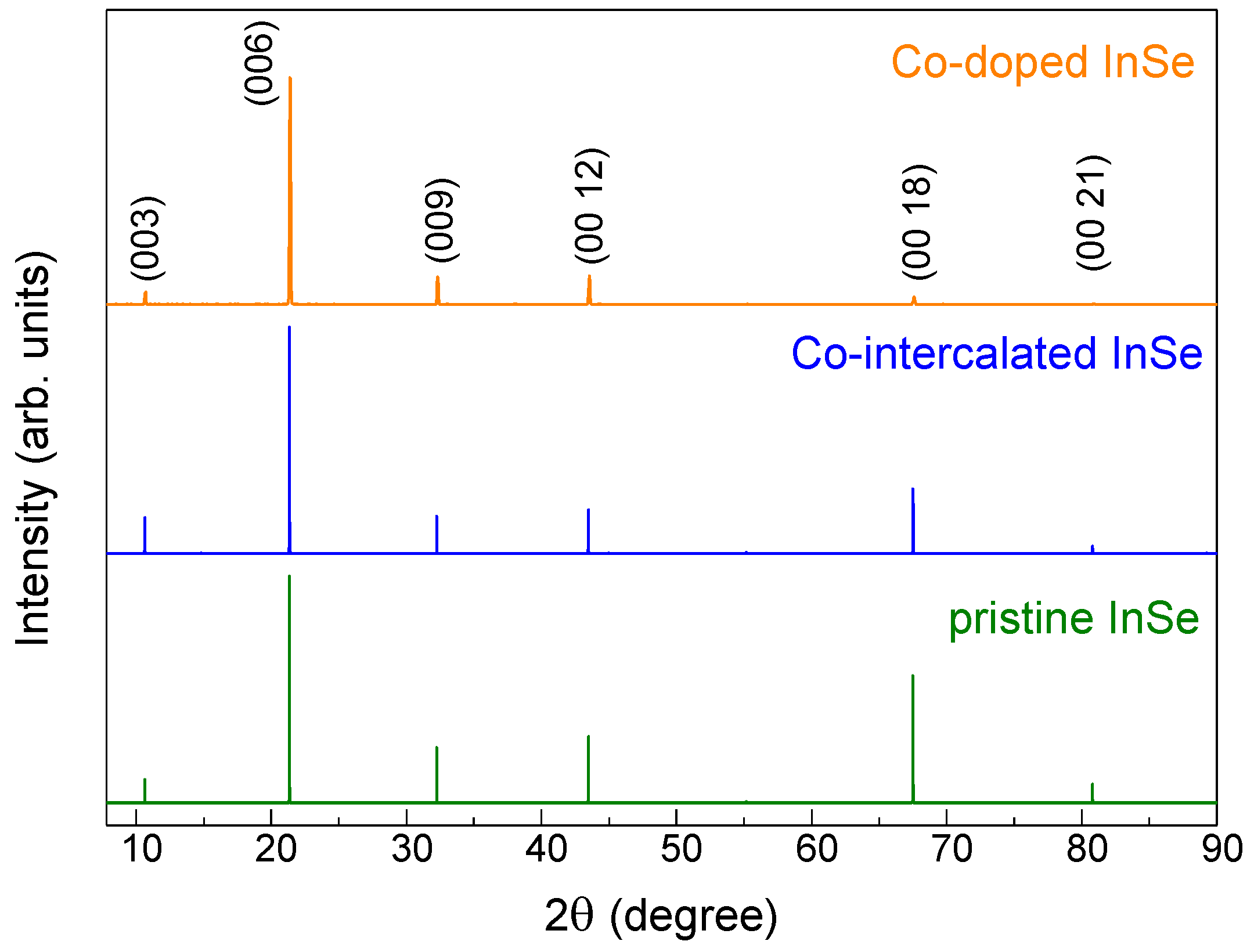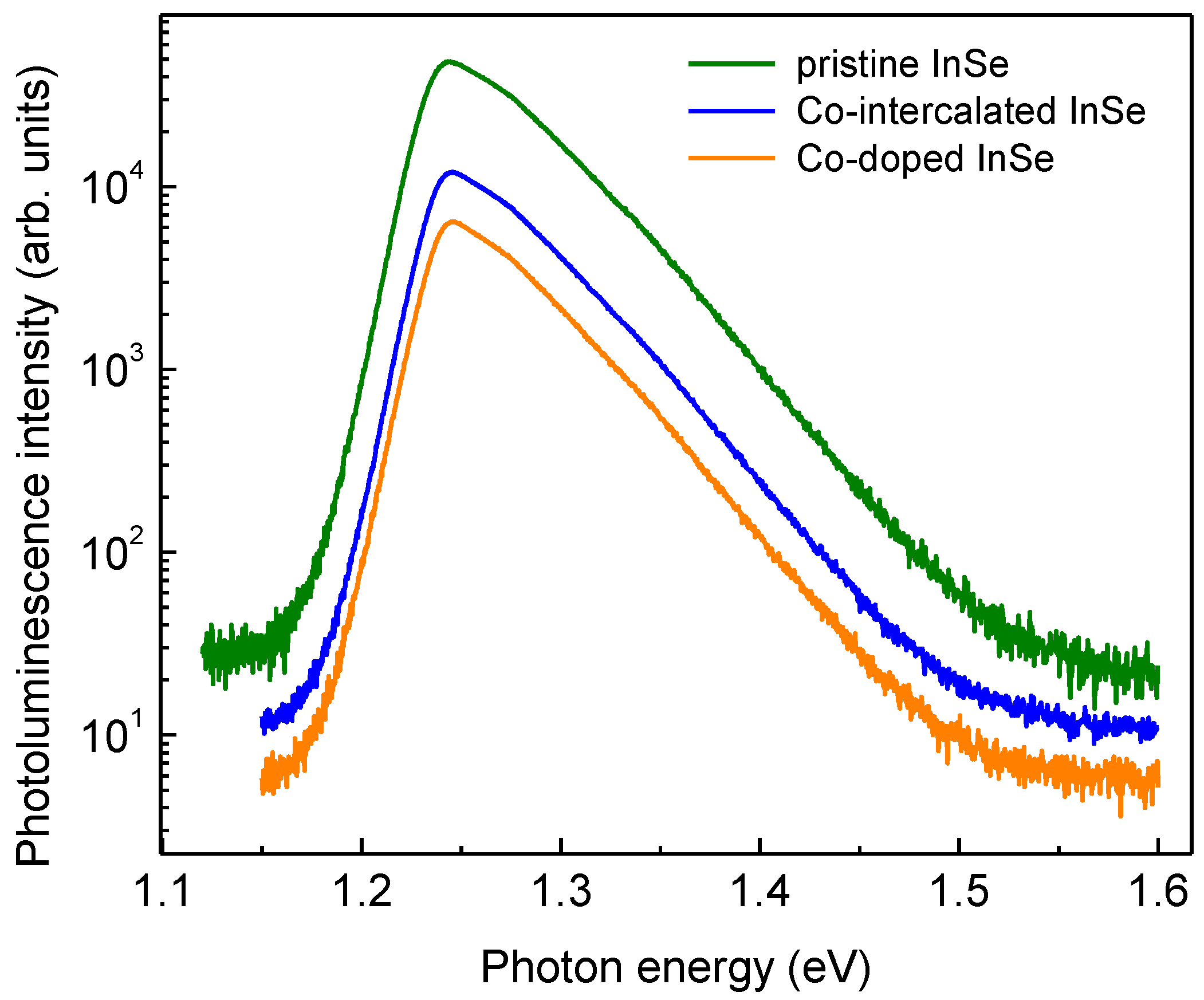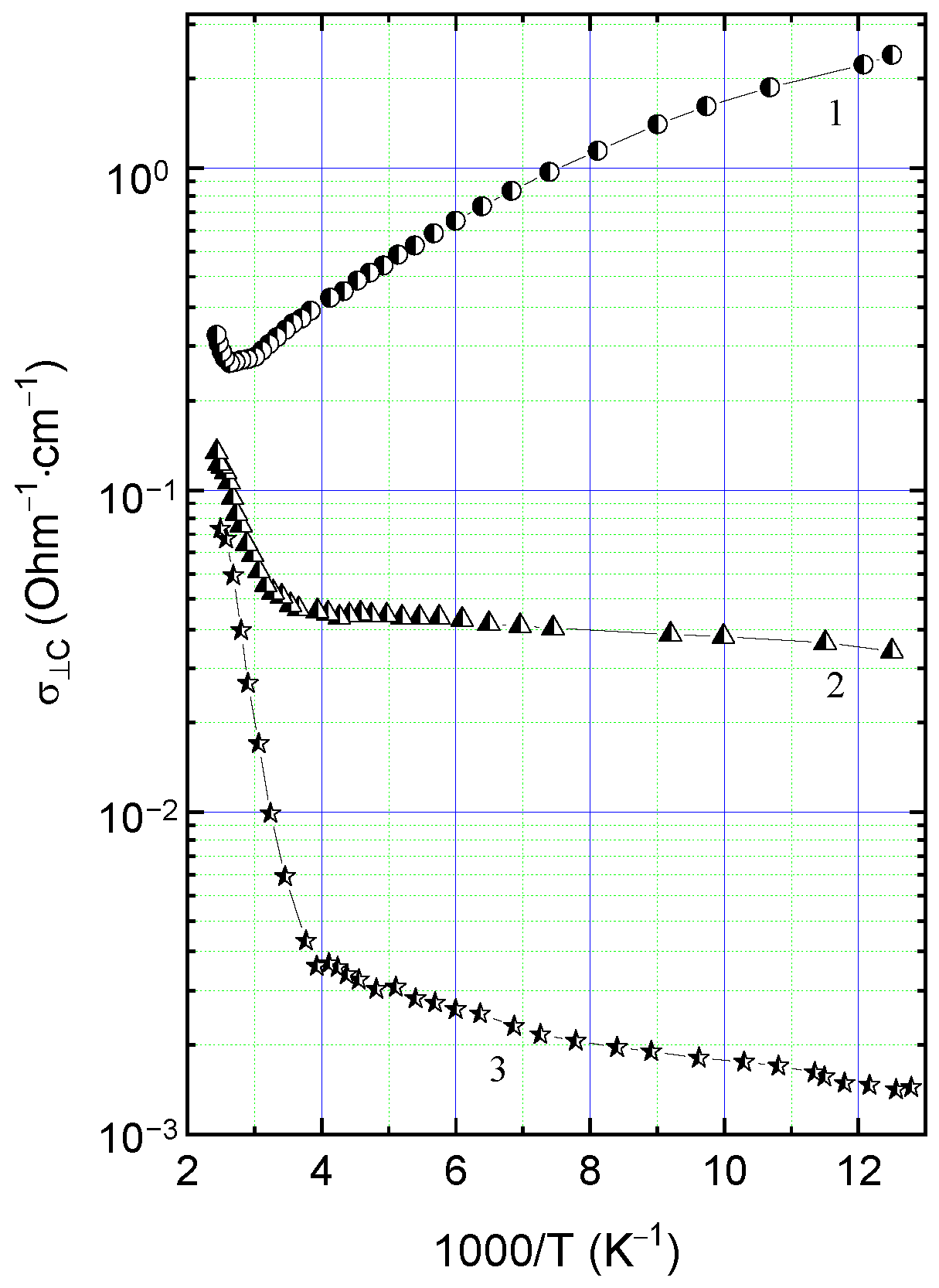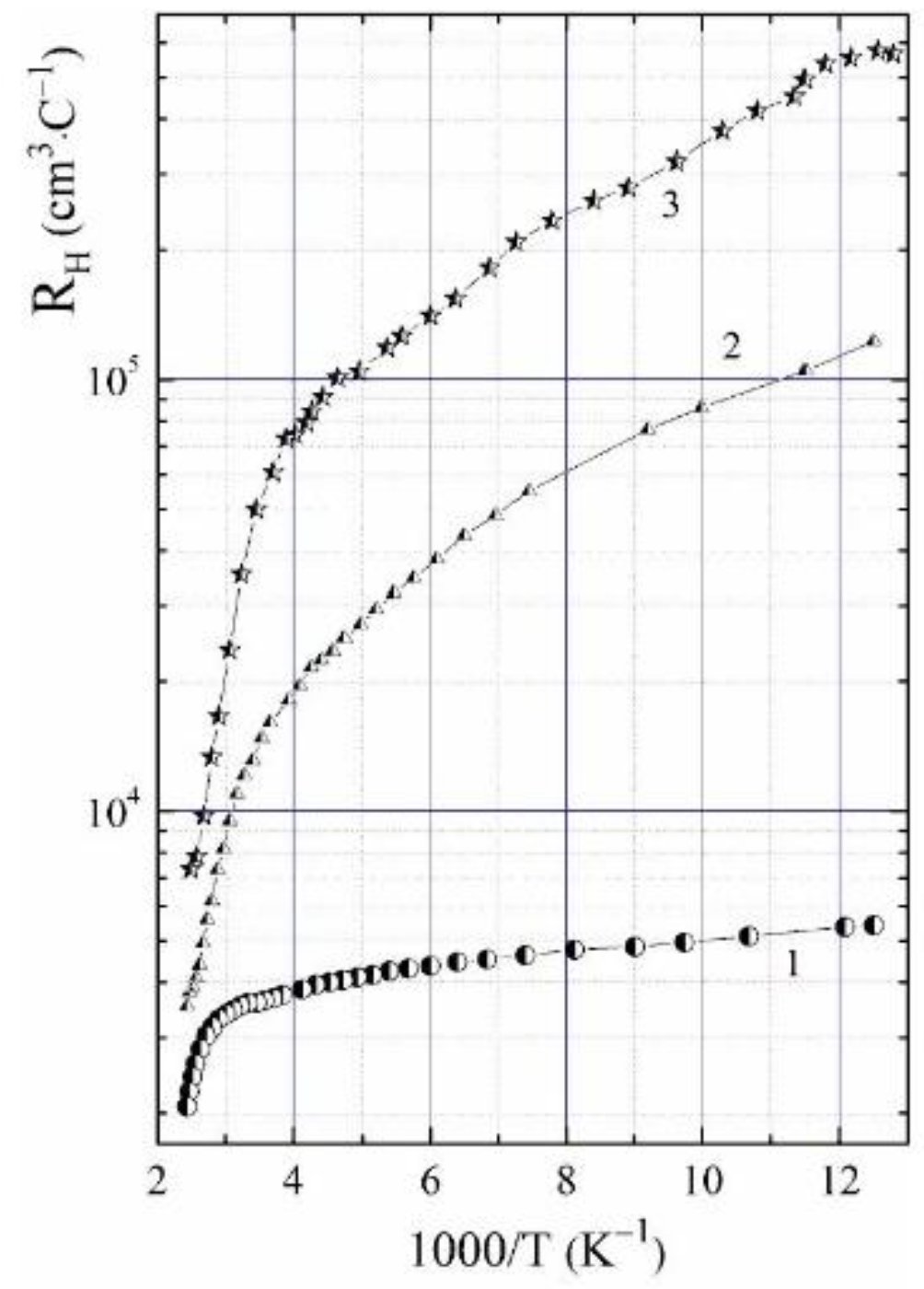Electron Transport in n-Type InSe van der Waals Crystals with Co Impurities
Abstract
1. Introduction
2. Materials and Methods
3. Results and Discussion
3.1. Crystal Structure, Surface Morphology and Optical Properties
3.2. Electrical Properties along InSe Layers
3.3. Electrical Conductivity Anisotropy
4. Conclusions
Author Contributions
Funding
Institutional Review Board Statement
Informed Consent Statement
Data Availability Statement
Conflicts of Interest
References
- Ares, P.; Novoselov, K.S. Recent advances in graphene and other 2D materials. Nano Mater. Sci. 2022, 4, 3–9. [Google Scholar] [CrossRef]
- Shanmugam, V.; Mensah, R.A.; Babu, K.; Gawusu, S.; Chanda, A.; Tu, Y.; Neisiany, R.E.; Försth, M.; Sas, G.; Das, O. A Review of the synthesis, properties, and applications of 2D Materials. Part. Part. Syst. Charact. 2022, 39, 2200031. [Google Scholar] [CrossRef]
- Liang, G.; Wang, Y.; Zhang, J.; Kudrynskyi, Z.R.; Kovalyuk, Z.; Patanè, A.; Xin, Q.; Song, A. High-performance phototransistors by alumina encapsulation of a 2d semiconductor with self-aligned contacts. Adv. Electron. Mater. 2022, 8, 2100954. [Google Scholar] [CrossRef]
- Venanzi, T.; Selig, M.; Pashkin, A.; Winnerl, S.; Katzer, M.; Arora, H.; Erbe, A.; Patanè, A.; Kudrynskyi, Z.R.; Kovalyuk, Z.D.; et al. Terahertz control of photoluminescence emission in few-layer InSe. Appl. Phys. Lett. 2022, 120, 092104. [Google Scholar] [CrossRef]
- Buckley, D.; Kudrynskyi, Z.R.; Balakrishnan, N.; Vincent, T.; Mazumder, D.; Castanon, E.; Kovalyuk, Z.D.; Kolosov, O.; Kazakova, O.; Tzalenchuk, A.; et al. Anomalous low thermal conductivity of atomically thin InSe probed by scanning thermal microscopy. Adv. Funct. Mater. 2021, 31, 2008967. [Google Scholar] [CrossRef]
- Mazumder, D.; Xie, J.; Kudrynskyi, Z.R.; Wang, X.; Makarovsky, O.; Bhuiyan, M.A.; Kim, H.; Chang, T.-Y.; Huffaker, D.L.; Kovalyuk, Z.D.; et al. Enhanced optical emission from 2D InSe bent onto Si-pillars. Adv. Opt. Mater. 2020, 8, 2000828. [Google Scholar] [CrossRef]
- Lv, Q.; Yan, F.; Mori, N.; Zhu, W.; Hu, C.; Kudrynskyi, Z.R.; Kovalyuk, Z.D.; Patanè, A.; Wang, K. Interlayer band-to-band tunneling and negative differential resistance in van der Waals BP/InSe field-effect transistors. Adv. Funct. Mater. 2020, 30, 1910713. [Google Scholar] [CrossRef]
- Ubrig, N.; Ponomarev, E.; Zultak, J.; Domaretskiy, D.; Zólyomi, V.; Terry, D.; Howarth, J.; Gutiérrez-Lezama, I.; Zhukov, A.; Kudrynskyi, Z.R.; et al. Design of van der Waals interfaces for broad-spectrum optoelectronics. Nat. Mater. 2020, 19, 299–304. [Google Scholar] [CrossRef]
- Kudrynskyi, Z.R.; Kerfoot, J.; Mazumder, D.; Greenaway, M.T.; Vdovin, E.E.; Makarovsky, O.; Kovalyuk, Z.D.; Eaves, L.; Beton, P.H.; Patanè, A. Resonant tunnelling into the two-dimensional subbands of InSe layers. Commun. Phys. 2020, 3, 16. [Google Scholar] [CrossRef]
- Bandurin, D.A.; Tyurnina, A.V.; Yu, G.L.; Mishchenko, A.; Zólyomi, V.; Morozov, S.V.; Kumar, R.K.; Gorbachev, R.V.; Kudrynskyi, Z.R.; Pezzini, S.; et al. High electron mobility, quantum Hall effect and anomalous optical response in atomically thin InSe. Nat. Nanotechnol. 2017, 12, 223–227. [Google Scholar] [CrossRef]
- Bhuiyan, M.A.; Kudrynskyi, Z.R.; Mazumder, D.; Greener, J.D.G.; Makarovsky, O.; Mellor, C.J.; Vdovin, E.E.; Piot, B.A.; Lobanova, I.I.; Kovalyuk, Z.D.; et al. Photoquantum Hall Effect and Light-Induced Charge Transfer at the Interface of Graphene/InSe Heterostructures. Adv. Funct. Mater. 2019, 29, 1805491. [Google Scholar] [CrossRef]
- Kudrynskyi, Z.R.; Bhuiyan, M.A.; Makarovsky, O.; Greener, J.D.G.; Vdovin, E.E.; Kovalyuk, Z.D.; Cao, Y.; Mishchenko, A.; Novoselov, K.S.; Beton, P.H.; et al. Giant Quantum Hall Plateau in Graphene Coupled to an InSe van der Waals Crystal. Phys. Rev. Lett. 2017, 119, 157701. [Google Scholar] [CrossRef] [PubMed]
- Zhu, W.; Lin, H.; Yan, F.; Hu, C.; Wang, Z.; Zhao, L.; Deng, Y.; Kudrynskyi, Z.R.; Zhou, T.; Kovalyuk, Z.D.; et al. Large tunneling magnetoresistance in van der Waals ferromagnet/semiconductor heterojunctions. Adv. Mater. 2021, 33, 2104658. [Google Scholar] [CrossRef] [PubMed]
- Gibertini, M.; Koperski, M.; Morpurgo, A.F.; Novoselov, K.S. Magnetic 2D materials and heterostructures. Nat. Nanotechnol. 2019, 14, 408–419. [Google Scholar] [CrossRef] [PubMed]
- Ningrum, V.P.; Liu, B.; Wang, W.; Yin, Y.; Cao, Y.; Zha, C.; Xie, H.; Jiang, X.; Sun, Y.; Qin, S.; et al. Recent advances in two-dimensional magnets: Physics and devices towards spintronic applications. Research 2020, 2020, 1768918. [Google Scholar] [CrossRef] [PubMed]
- Basnet, R.; Ford, D.; TenBarge, K.; Lochala, J.; Hu, J. Emergence of ferrimagnetism in Li-intercalated NiPS3. J. Phys. Condens. Matter 2022, 34, 434002. [Google Scholar] [CrossRef]
- Kovalyuk, Z.D.; Boledzyuk, V.B.; Shevchyk, V.V.; Kaminskii, V.M.; Shevchenko, A.D. Ferromagnetism of layered GaSe semiconductors intercalated with cobalt. Semiconductors 2012, 46, 971–974. [Google Scholar] [CrossRef]
- Bakhtinov, A.P.; Boledzyuk, V.B.; Kovalyuk, Z.D.; Kudrynskyi, Z.R.; Lytvyn, O.S.; Shevchenko, A.D. Magnetic properties and surface morphology of layered In2Se3 crystals intercalated with cobalt. Phys. Solid State 2013, 55, 1148–1155. [Google Scholar] [CrossRef]
- Boledzyuk, V.B.; Kovalyuk, Z.D.; Pyrlya, M.N.; Shevchenko, A.D. Electrochemical, optical, and magnetic properties of NixInSe (0 <x ≤ 1) intercalation compounds. Inorg. Mater. 2014, 50, 976–980. [Google Scholar] [CrossRef]
- Boledzyuk, V.B.; Kovalyuk, Z.D.; Kudrynskyi, Z.R.; Litvin, O.S.; Shevchenko, A.D. Structure and magnetic properties of cobalt-intercalated layered InSe crystals. Tech. Phys. 2014, 59, 1462–1465. [Google Scholar] [CrossRef]
- Boledzyuk, V.B.; Kovalyuk, Z.D.; Kudrynskyi, Z.R.; Pyrlya, M.N.; Feshak, T.N.; Shevchenko, A.D. Electrochemical, optical, and magnetic properties of NixGaSe (0 <x ≤ 1) intercalation compounds. Inorg. Mater. 2015, 51, 1086–1089. [Google Scholar] [CrossRef]
- Boledzyuk, V.; Bakhtinov, A.; Kovalyuk, Z.; Kudrynskyi, Z.; Ivanov, V.; Slyn’ko, V. Preparation of nanocomposite magnetic compounds based on layered semiconductors by means of electrochemical intercalation in a gradient magnetic field. Acta Phys. Pol. A 2016, 130, 773–777. [Google Scholar] [CrossRef]
- Slyn’ko, V.V.; Khandozhko, A.G.; Kovalyuk, Z.D.; Slyn’ko, V.E.; Zaslonkin, A.V.; Arciszewska, M.; Dobrowolski, W. Ferromagnetic states in the InSe1-xMnxSe layered crystal. Phys. Rev. B 2005, 71, 245301. [Google Scholar] [CrossRef]
- Lashkarev, G.V.; Sichkovskiyi, V.I.; Radchenko, M.V.; Karpina, V.A.; Butorin, P.E.; Dmitriev, O.I.; Lazorenko, V.I.; Slyn’ko, E.I.; Lytvyn, P.M.; Jakiela, R.; et al. Diluted magnetic semiconductors based on II–VI, III–VI, and IV–VI compounds. Low Temp. Phys. 2009, 35, 62–70. [Google Scholar] [CrossRef]
- Lashkarev, G.V.; Sichkovskyi, V.I.; Radchenko, M.V.; Aleshkevych, P.; Dmitriev, O.I.; Butorin, P.E.; Kovalyuk, Z.D.; Szymczak, R.; Slawska-Waniewska, A.; Nedelko, N.; et al. Diluted magnetic layered semiconductor InSe:Mn with high Curie temperature. Semicond. Phys. Quantum Electron. Optoelectron. 2011, 14, 263–268. [Google Scholar] [CrossRef][Green Version]
- Moro, F.; Bhuiyan, M.A.; Kudrynskyi, Z.R.; Puttock, R.; Kazakova, O.; Makarovsky, O.; Fay, M.W.; Parmenter, C.; Kovalyuk, Z.D.; Fielding, A.J.; et al. Room temperature uniaxial magnetic anisotropy induced by fe-islands in the inse semiconductor van der Waals crystal. Adv. Sci. 2018, 5, 1800257. [Google Scholar] [CrossRef] [PubMed]
- El-Sayed, K.; Heiba, Z.K.; Sedeek, K.; Hantour, H.H. Magnetic, electric and crystallographic properties of diluted magnetic InSe(1−x)Fe(Co)x semiconductor. J. Alloys Compd. 2012, 530, 102–106. [Google Scholar] [CrossRef]
- Lashkarev, G.V.; Slynko, V.V.; Kovalyuk, Z.D.; Sichkovskyi, V.I.; Radchenko, M.V.; Aleshkevych, P.; Szymczak, R.; Dobrowolski, W.; Minikaev, R.; Zaslonkin, A.V. Anomalies of magnetic properties of layered crystals InSe containing Mn. Mater. Sci. Eng. C 2007, 27, 1052–1055. [Google Scholar] [CrossRef]
- Rigoult, J.; Rimsky, A.; Kuhn, A. Refinement of the 3R γ-indium monoselenide structure type. Acta Crystallogr. Sect. B 1980, 36, 916–918. [Google Scholar] [CrossRef]
- Segura, A.; Wünstel, K.; Chevy, A. Investigation of impurity levels inn-type indium selenide by means of Hall effect and deep level transient spectroscopy. Appl. Phys. A 1983, 31, 139–145. [Google Scholar] [CrossRef]
- Schmid, P. Electron-lattice interaction in layered semiconductors. Il Nuovo Cim. B (1971–1996) 1974, 21, 258–270. [Google Scholar] [CrossRef]
- Savitskii, P.I.; Kovalyuk, Z.D.; Mintyanskii, I.V. Space-charge region scattering in indium monoselenide. Phys. Status Solidi A 2000, 180, 523–531. [Google Scholar] [CrossRef]
- Zaslonkin, A.V.; Kovalyuk, Z.D.; Mintyanskii, I.V.; Savitskii, P.I. Electrical properties of fast cooled InSe single crystals. Semicond. Phys. Quantum Electron. Optoelectron. 2008, 11, 54–58. [Google Scholar] [CrossRef]
- Weisberg, L.R. Anomalous mobility effects in some semiconductors and insulators. J. Appl. Phys. 1962, 33, 1817–1821. [Google Scholar] [CrossRef]
- Kim, S.E.; Mujid, F.; Rai, A.; Eriksson, F.; Suh, J.; Poddar, P.; Ray, A.; Park, C.; Fransson, E.; Zhong, Y.; et al. Extremely anisotropic van der Waals thermal conductors. Nature 2021, 597, 660–665. [Google Scholar] [CrossRef] [PubMed]
- Suzuki, M.; Gao, B.; Shibata, G.; Sakamoto, S.; Nonaka, Y.; Ikeda, K.; Chi, Z.; Wan, Y.X.; Takeda, T.; Takeda, Y.; et al. Magnetic anisotropy of the van der Waals ferromagnet Cr2Ge2Te6 studied by angular-dependent x-ray magnetic circular dichroism. Phys. Rev. Res. 2022, 4, 013139. [Google Scholar] [CrossRef]
- Shu, H. Highly-anisotropic carrier transport and optical properties of two-dimensional titanium trisulfide. J. Mater. Sci. 2022, 57, 3486–3496. [Google Scholar] [CrossRef]
- Gomes da Costa, P.; Dandrea, R.G.; Wallis, R.F.; Balkanski, M. First-principles study of the electronic structure of g-InSe and B-InSe. Phys. Rev. B 1993, 48, 14135–14141. [Google Scholar] [CrossRef]
- Pomer, F.; Bonet, X.; Segura, A.; Chevy, A. Electrical conductivity anisotropy in tin-doped n-type indium selenide. Phys. Status Solidi B 1988, 145, 261–268. [Google Scholar] [CrossRef]
- Guo, Z.; Zeng, Y.; Meng, F.; Qu, H.; Zhang, S.; Hu, S.; Fan, S.; Zeng, H.; Cao, R.; Prasad, P.N.; et al. In-situ neutron-transmutation for substitutional doping in 2D layered indium selenide based phototransistor. eLight 2022, 2, 9. [Google Scholar] [CrossRef]
- Zhang, X.; Liu, W.; Niu, W.; Lu, Q.; Wang, W.; Sarikhani, A.; Wu, X.; Zhu, C.; Sun, J.; Vaninger, M.; et al. Self-intercalation tunable interlayer exchange coupling in a synthetic van der Waals antiferromagnet. Adv. Funct. Mater. 2022, 32, 2202977. [Google Scholar] [CrossRef]
- Liu, Y.; Hu, Z.; Tong, X.; Bauer, E.D.; Petrovic, C. Electrical and thermal transport in van der Waals magnets 2H–MxTaS2 (M = Mn, Co). Phys. Rev. Res. 2022, 4, 013048. [Google Scholar] [CrossRef]
- Wang, Y.; Jiang, S.; Xiao, J.; Cai, X.; Zhang, D.; Wang, P.; Ma, G.; Han, Y.; Huang, J.; Watanabe, K.; et al. Ferroelectricity in hBN intercalated double-layer graphene. Front. Phys. 2022, 17, 43504. [Google Scholar] [CrossRef]








| Samples | (Å) | (Å) |
|---|---|---|
| Pristine InSe | 4.002 ± 0.003 | 24.950 ± 0.012 |
| Co-intercalated | 4.003 ± 0.006 | 24.952 ± 0.002 |
| Co-doped InSe | 4.012 ± 0.015 | 24.908 ± 0.022 |
| Sample No | Type of Sample | σ⊥C, Ohm−1·cm−1 | n, cm−3 | μ⊥C, cm2·V−1·s−1 | |||
|---|---|---|---|---|---|---|---|
| 80 K | 300 K | 80 K | 300 K | 80 K | 300 K | ||
| 1 | Undoped | 2.243 | 0.298 | 1.15 × 1015 | 1.74 × 1015 | 12,180 | 1070 |
| 2 | Co-intercalated | 3.17 × 10−2 | 4.82 × 10−2 | 5.09 × 1013 | 5.16 × 1014 | 3890 | 584 |
| 3 | Co-doped | 1.38·× 10−3 | 9.92 × 10−3 | 1.09 × 1013 | 1.77 × 1014 | 794 | 350 |
| Sample | Type of Sample | σ‖C, Ohm−1·cm−1 | σ⊥C/σ‖C | ΔEb, meV | A(80 K) | ||
|---|---|---|---|---|---|---|---|
| 80 K | 300 K | 80 K | 300 K | ||||
| 1 | Undoped | 6.87 × 10−4 | 2.42 × 10−2 | 3265 | 12.3 | 41.9 | 7.5 |
| 2 | Co-intercalated | 2.09 × 10−4 | 6.33 × 10−3 | 151.3 | 7.62 | 19.1 | 9.5 |
| 3 | Co-doped | 7.03 × 10−5 | 1.587 × 10−3 | 19.6 | 6.29 | 16.6 | 1.8 |
Publisher’s Note: MDPI stays neutral with regard to jurisdictional claims in published maps and institutional affiliations. |
© 2022 by the authors. Licensee MDPI, Basel, Switzerland. This article is an open access article distributed under the terms and conditions of the Creative Commons Attribution (CC BY) license (https://creativecommons.org/licenses/by/4.0/).
Share and Cite
Kudrynskyi, Z.R.; Mintyanskii, I.V.; Savitskii, P.I.; Kovalyuk, Z.D. Electron Transport in n-Type InSe van der Waals Crystals with Co Impurities. Appl. Sci. 2022, 12, 9932. https://doi.org/10.3390/app12199932
Kudrynskyi ZR, Mintyanskii IV, Savitskii PI, Kovalyuk ZD. Electron Transport in n-Type InSe van der Waals Crystals with Co Impurities. Applied Sciences. 2022; 12(19):9932. https://doi.org/10.3390/app12199932
Chicago/Turabian StyleKudrynskyi, Zakhar R., Illya V. Mintyanskii, Petro I. Savitskii, and Zakhar D. Kovalyuk. 2022. "Electron Transport in n-Type InSe van der Waals Crystals with Co Impurities" Applied Sciences 12, no. 19: 9932. https://doi.org/10.3390/app12199932
APA StyleKudrynskyi, Z. R., Mintyanskii, I. V., Savitskii, P. I., & Kovalyuk, Z. D. (2022). Electron Transport in n-Type InSe van der Waals Crystals with Co Impurities. Applied Sciences, 12(19), 9932. https://doi.org/10.3390/app12199932







